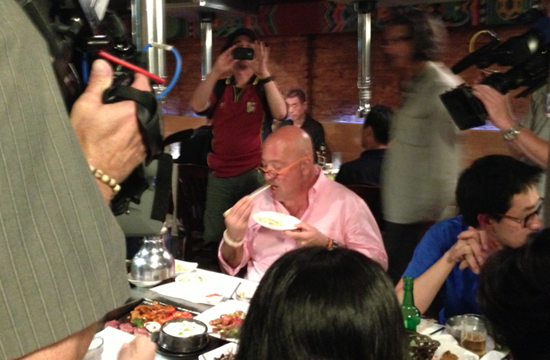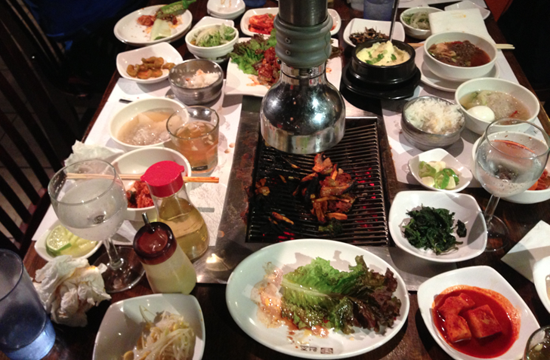The Choreography of Eating: Behind The Scenes of Bizarre Foods with Andrew Zimmern
I almost missed Andrew Zimmern slipping quietly into the Korean BBQ restaurant, until I noticed that no other man in a pink shirt would ever wear orange-accented glasses.
The production crew had said he and Bizarre Foods would arrive at 9:30 PM, shooting a segment for Bizarre Foods at New WonJo in Koreatown in the dead of night, and invited me to come along. I arrived at 9:15, and ended up lolling at the front for another forty-five minutes, yawning as the clock crept closer to midnight, and suddenly, Zimmern materialized at a table hidden behind the host stand, along with two burlier body guards.
For the most part, no one spotted him tapping away on his phone, save for one fan exiting the restaurant, a young Asian man who darted back in as soon as he realized who he’d passed: “I’m a huge fan,” he mumbled, and zipped back out as soon as Zimmern had thanked him.
And then we sat in the reception area while his crew set up an array of lights and cameras, visible to the tourists, workers, and everyone else passing by on 35th Street.
The Braiser: I have to say, you’re really good at hiding from people.
Zimmern: In plain sight. Although in a pink shirt.
Does everything change when the cameras come in, and people go “Whoa! It’s that guy!”
Well, it’s hard to hide nine, ten people and the equipment. Even though we’re a very lightly treading show, the minute people like Graham walk by with lights like those, [points to a PA walking by with an enormous light rig], it’s sort of a giveaway…
And unfortunately for us, it changes the dynamic of what we’re able to record. Now, in a restaurant like this, people are busy — they’re eating and they want to eat, so it becomes a little easier. If we’re in a night club or at a bar, I want to capture the spirit of what that place is. But the minute you turn on the lights and turn on the cameras, everything sort of changes. It’s a little dicey, sometimes, but we try. As lightly imprinted as possible.
Does that play into where you choose to shoot? Or is it thematically-based?
No, you kind of choose the story you want to tell, then figure out all the problems you need to move past to shoot it.
So then what’s the story with this New York episode? You could, literally, film 80 million episodes about New York’s food scene.
You could. Actually, I’ll flip it around on you: everyone has done about a million episodes on TV here. When we went and did our Los Angeles episode, or when we did our New York episode now, what I try to figure out is —
A middle-aged Korean waitress from the restaurant magically appears on the bench out of nowhere, and swiftly wraps Zimmern into a side-hug.”We’re taking a picture!” she insists, and whips out a pastel pink phone covered in white cherry blossoms.
What I try to figure out —
She thrusts the camera between me and Zimmern, pulling him in for a blitz of selfies. The flash goes off. She takes another photo, and another. Zimmern is the avatar of patience.
Yeah. That’s me. And you. Again.
“You’re so cute,” she giggles. Zimmern leans in for the fourteenth photo and keeps talking to me, but she keeps clinging onto his arm.
Here’s what you have to challenge yourself with: You have to challenge yourself with how to shoot — hold on.
He takes her phone, and through some sort of technological wizardry, gets it to snap ten photos in a three-second span of the two sitting on the same bench. “Ooooh! Thank you, thank you, thank you,” she squeals, running off with her cache of celebrity photos — and instantly Zimmern’s attention snaps back to me.
— You have to figure out a different way to tell stories that people haven’t seen before.
So what we did in Los Angeles, we did the hidden communities people haven’t tapped into. In New York, we’re doing “New York After Hours.” So we’re shooting at ten at night until seven in the morning, and we’re doing places that are, really, most vibrant in the middle of the night. If people want to catch up with me on this trip, they need to be up at four in the morning.
And this place is open 24 hours.
Correct! And there are a lot of Korean businesses here — particularly financial services businesses — who are actually working a Korean schedule. So at three in the morning, they come downstairs for lunch.
…The first way we enjoy another culture is by eating it. My goal, in a small way with our show, is to educate people about the food and move them into seeing that the people behind the food are just like you and I.
I was hoping that was going to happen with Border Check. Is that ever coming back?
Over the next couple of months? No. But I think that concept is brilliant for television. I think that —
An Indian man walks up to us with a shy wave and a polite greeting to Zimmern. In his hand (on his phone, obviously) is a photo of the two men standing in front of a tent at a food festival.”Remember that?” he asks. “It was a long time ago, I don’t know if you remember me –“
Yeah, look at that! Yeah, of course I remember that!
“That’s me and you,” the bewildered man says. “You remember that?”
Yeah, I do! Nice to see you again. What a small world!
Flustered with excitement, the man says goodbye, dashing back to his shop around the corner.
Did you actually recognize him?
Yeah! He had that picture, and I remember him taking it — I actually remember him taking the picture. But yeah, Border Check is a brilliant concept for a TV show, and at some point, I’m gonna make it.
Is it easier to shoot in a country where you’re not being mobbed every twenty seconds by a fan?
Yes. We shot a show in Toronto a couple of weeks ago, and the Travel Channel is on in Canada, but it’s part of a cable package that’s spendy and a lot of people don’t have it. It was so easy to do everything. I mean, there are a lot of tourists in Toronto in the summertime, so we got mobbed, but we haven’t gotten mobbed the same way.
New York’s probably gotta be —
The worst.
The worst.
For whatever reason, and I can’t explain it — I mean, obviously, New York is my hometown. I was born and raised here, it’s the largest television market, and I have a lot of fans. It’s even harder for me shooting on this street. So many people come here because they’re food freaks. 99% of the people who eat here watch the show. And for some reason, I’m fetishized in a lot of Asian countries.
[I die laughing because it’s true.]
No, seriously! They see me as someone who’s one of their cheerleaders. You saw what happened with that older lady who’s one of the servers here? She does that every time I come to New WonJo.
You come here often?
At least once every couple of months. There are a couple of places that get a little more press —
And, as if on cue, yet another Korean fan cuts in. “I saw you on a website,” she says. They exchange pleasantries, she leaves aglow.
See? There. It happened again.
But yeah, they do some really cool things here. The cooked food that comes out of the kitchen here is special, too — they have some great noodle dishes, some beef — the food here is really, really good. And I like some of their banchan, too.There’s some dried fish banchan I’m really fond of. The cold buckwheat noodles — they actually have them on special tonight, with a spicy beef broth — is out of control good. It really depends on what I want to eat, but the last time I was in New York, I actually ate here.
Did you read the Robert Sietsema article in the New York Times about the restaurants in Atlantic City? You would love it. It’s August, it’s a really nice drive, it’s two hours. You’ll get there, eat some pho, walk on the beach, gamble…but just smelling the broths there, you’ll know you’re in the right place.
Stop making me homesick.
[shrugs] Eh, it’s my job.
And then he went to do his job.
The four Korean students were halfway through grilling their first plate of raw wagyu beef when Zimmern’s director politely asked them if they could keep their party going — and, just a small thing, to pretend that there weren’t any cameras zeroed in on the bald man sitting at the other end of their table.
“We didn’t know who the guy was,” one of them, a student from a prominent engineering school, shrugged. “But they want us to keep eating and drinking, so…”
What will likely end up a five-minute conversation between Zimmern and a friend/local food blogger, aired during an hourlong primetime program about late night eating in New York, will take two hours to shoot — but still needs to look like five, continuous, non-jarring minutes. Sure, some of the diners around them (all straining to pretend that everything is normal, trying not to be That Guy) might finish their meals and head out in the middle of the shoot, but viewers tend to notice if the group of Korean students sitting next to Zimmern has mysteriously turned into, say, two Irish couples on a double date.
Other things matter, too. The shoot won’t start until the detritus of the last party’s meal’s been cleared off the table behind Zimmern. For a normal viewer, it looks disgusting, Zimmern points out. The lights need to be angled just so. And for a naturalistic, documentary-type show, the camera crew has to film Zimmern and his friend walking into the restaurant and sitting down — twice. (The second time was because the director noticed that a chrome pipe, serving as a chimney for the indoor grill, bisected the diners in the frame — a fun narrative trick of cinematography, maybe, but one heck of an annoyance to the practical cameraman.)
Is this old hat to anyone who works in the television industry? Probably — especially the parts where Zimmern will freeze, glass noodles an inch from his mouth, and wait as the camera crew figures out how to recompose themselves; or the parts where he’ll halt midway through a sentence the moment he notices a waiter carrying an enormous box of red-hot coals by the table, for instance. “Shoot that,” he suddenly says. “Shoot that, shoot that, shoot that” — and one of the three cameramen pivots instantly, tracking the burning box casually winding through so many polyester-clad people.
“–and it’s just amazing,” he finishes, as if he’d never stopped. It’s like watching a version of Bizarre Foods on a VCR, except with a baby mashing the pause and rewind buttons at random intervals.
What doesn’t change: the dozens of plates that pile up on the table, clamoring for his attention as the waitress keeps dropping them off to the point where they overlap each other. Soft shell crabs. Japchae, a riot of clear noodles and julienned vegetables. A collection of various soups and stews, parts from large animals and tinier animals meant to be eaten whole. Raw vegetables, and, more importantly, raw meat, to cook on the built-in grill and stuff into Zimmern’s face, with a well-practiced, but still sincere, “Oh. Oh, this is delicious.” However, the limitations of the human stomach, as well as the fact that he’s going to yet another restaurant, keeps him from cleaning up the pile of plates. Thankfully, as a PA whispers to me, he has an entire hungry production crew with him, and it’s a late night.
Behind Zimmern, the Korean students clink their beers, the third (or fourth?) of the night. The director mouths “Good!” to them, flashing a thumbs up, then goes back to fixating on the viewfinder.
Making food television isn’t easy, I notice, as the whirlwind of production spins around me. Yeah, that might be the understatement of the decade, but who doesn’t love the romance sold by food television? Zimmern gets paid to eat! He gets to travel and talk to people and teach an audience of millions about different cultures! But wait, there’s a pipe in the way of the camera — where should they eat now? And his avuncular face looks weird in this light. The lights need to be adjusted. We couldn’t hear the waitress describe the dish — can she come in and say it again? And could you keep holding that bowl for one more second, Andrew? The spontaneous, natural act of sharing a meal, eating with friends, has never seemed so carefully choreographed. The only thing that would make it more artificial is if the gray-haired director asked Zimmern to talk about banchon once more, with feeling.
Zimmern cheerfully finishes up his enormous meal, and thanks his waitress and the hosts. The Korean students behind him look as if they’re about to pass out, unable to keep pace with the pro. (They revive a little once they learn that their dinner’s been paid for in full.)
And, just like that, they’re gone — the cameramen disappear, the crew whisks away the lighting rigs, the major TV star ducks out for a breath of anonymous fresh air. The only sign that anyone had been doing something unusual at the restaurant: a vista of plates spread over two enormous tables, half-filled with food, as if a very strategic glutton had wanted to try one of everything the world could offer.
RELATED:
Breakfast With Bobby Flay: On Creativity, Competition, and Being the Mayor of New York City
Andrew Zimmern Talks New Season Of Bizarre Foods, Top Chef: NOLA, And Our ‘Gotcha’ Culture
WATCH: Behind The Scenes At The 21st Century Limited
Have a tip we should know? tips@mediaite.com










